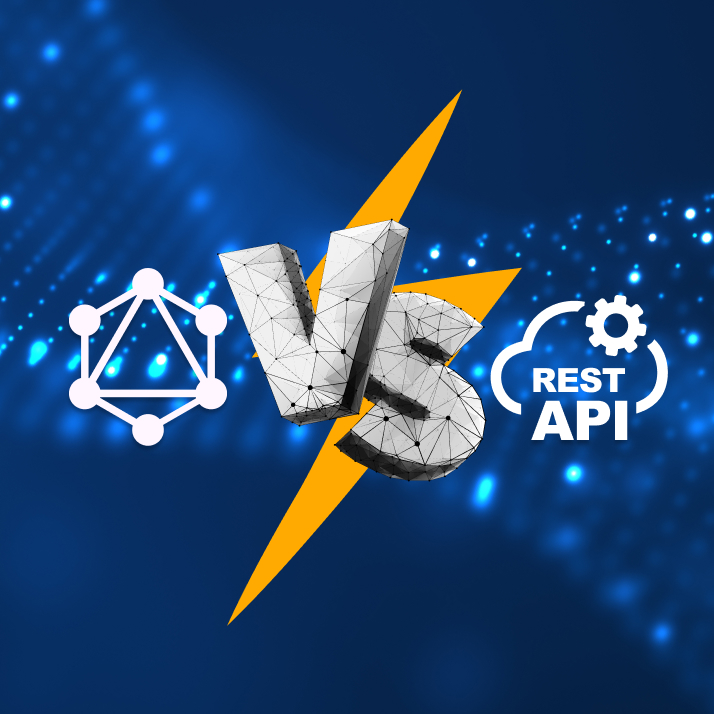GraphQL has gained significant acclaim as a superior alternative to REST, as it introduces an improved way of developing APIs. A prevailing notion among developers is that GraphQL could replace REST in the long run. In fact, many developers have already recognized GraphQL’s capacity to address common obstacles encountered when developing REST APIs. They stand in stark contrast to each other. They both involve transmitting an HTTP request and receiving a corresponding outcome. Each of them boasts its own pros and cons. Therefore, choosing between them can be even more challenging for a web development company.
In this blog, we will delve extensively into these two groundbreaking technologies that have revolutionized the landscape of API development and scalability.
An Insight into GraphQL
It functions as both an API query language and a runtime designed to respond to queries using pre-existing data. Additionally, it boasts robust tools tailored to manage even the most complicated queries effectively.
GraphQL can solicit and receive only the specific data requested stipulated. It thereby streamlines the process of scaling your APIs in conjunction with your application. The most captivating facet of GraphQL is its capacity to furnish comprehensive data in one endpoint. To utilize GraphQL effectively in your website creation project, you can take the help of the best web development company in USA.
Facebook introduced this API development methodology to address their mobile app developers’ challenges when working with REST APIs. Since the launch of the initial open-source version, it has witnessed remarkable growth, driven by its adoption by prominent players in the technology industry.
Let’s see why a web development company should utilize this technology while building APIs.
Application of GraphQL in Web Development
- Full exploitation of GraphQL is feasible when augmenting the capabilities of an existing API.
- It is useful when a website development company in USA has to simplify complex API.
- The utilization of GraphQL is apt when consolidating data from multiple sources into a unified, user-friendly API.\
- GraphQL can serve as an abstraction layer atop an existing API, permitting the specification of response structures aligned with user requirements.
Let’s now come to RESTful API.
An Insight into REST
REST is an acronym for “Representational State Transfer”. It outlines fundamental principles and restrictions regarding the exchange of resources between servers and clients. Adhering to these principles in API results in the categorization of the API’s functionality as “RESTful.” The WordPress REST API aptly exemplifies this concept.
Application of REST in Web Development
- REST facilitates seamless communication among web applications developers create using different programming languages.
- Leveraging REST, these web applications can coexist in distinct environments, spanning Windows or Linux platforms.
- A website development company in USA can ensure the portability of user interfaces across various platforms.
- Developers can attain a standardized interface.
Now that you have a fair understanding of these two technologies, let’s see who emerges victorious in the “GraphQL vs. REST API” comparison.
Similarities Between GraphQL and REST
Both of them are widely used approaches for enabling the exchange of data between different applications within the context of a client-server model. Additionally, both these technologies enable web development companies in NYC to utilize APIs for creating and modifying data across separate applications, services, or modules.
APIs built by a web development company using the REST approach are commonly referred to as RESTful APIs or REST APIs, whereas those created with GraphQL are simply termed GraphQL APIs.
The Differences between GraphQL and REST
In GraphQL, the user leverages queries to ask for data. On the other hand, in the case of REST, the client dispatches an HTTP request to acquire data, subsequently receiving it as an HTTP response. Let’s check out some other key distinctions between these two.
Data Control
Do you know why GraphQL is preferred the most when choosing a robust tech stack for web development in New York? With GraphQL, you attain greater data control as it permits you to precisely request the exact information you require within a single query.
Conversely, REST APIs come with comparatively more constrained data control, as each request must be customized to align with the specific data being solicited.
Speed & Efficiency
REST APIs excel in speed and efficiency due to their ability to rapidly return substantial volumes of data. While GraphQL is also fast, it can be slower than REST, particularly when dealing with complex data requests or scenarios that involve multiple queries.
Learning Curve
Mastering GraphQL comes with a significant learning curve, demanding a solid grasp of API development and general software engineering principles. For someone new to the field, comprehending GraphQL thoroughly enough to construct complex applications can be quite challenging.
On the other hand, REST is considerably easier for beginners, requiring less initial domain knowledge. RESTful APIs are seamlessly integrated into a wide array of major programming languages and popular frameworks, thereby simplifying the learning process.
Set-up and Maintenance
Setting up and maintaining REST APIs is easier due to their utilization of widely adopted standard protocols. On the other hand, GraphQL demands custom code and a dedicated GraphQL schema, making its setup and maintenance comparatively more complicated.
Rapid Prototyping
GraphQL proves highly beneficial for swift prototyping. This is because a web development company working on building APIs using GraphQL can gather data through a single response to a query. On the other hand, REST APIs are more suitable for complex applications that demand extensive data manipulation.
Error Handling
REST APIs generally excel in error handling because they use standard protocols, which are easier to monitor. They employ distinct HTTP statuses to indicate different states of API requests.
In contrast, GraphQL can introduce complexities in problem monitoring and integration with essential monitoring tools. This is because it consistently returns a 200 Ok status for all API requests, even when errors occur.
Final Thoughts
This blog gave an insight into GraphQL and REST, two prominent technologies used in the development of APIs. Additionally, it also covered the similarities and differences between GraphQL and REST.
Is GraphQL better than REST when it comes to API creation? Well, selecting between them will depend on your specific requirements, as both come with their own benefits. You must hire dedicated web developers to employ these technologies in your web development project effectively.
Summary:
GraphQL and REST are two popular technologies that are used in developing APIs. Both come with their own pros, making it difficult for developers to choose between the two. GraphQL is beneficial when a developer has to simplify complex API. Additionally, the use of GraphQL is apt when you have to consolidate data from different sources into a unified, user-friendly API. Let’s learn about REST. REST allows for smooth communication among web apps that are created by developers leveraging different programming languages. Additionally, using REST, a website development company can ensure the portability of user interfaces across various platforms. Moreover, REST also enables developers to attain a standardized interface. Both these API-building technologies are similar in some ways. For instance, these are used for enabling the data exchange between applications in a client-server model. Also, both GraphQL and REST allow website development teams to leverage APIs for creating data across applications, services, or modules. Despite being similar, these two are different in many ways. For instance, when it comes to data control, GraphQL is the preferred choice. In terms of speed and efficiency, REST APIs outperform GraphQL. In the case of swift prototyping, GraphQL proves highly beneficial as a user can gather data through a single response to a query. This makes it better than REST. Since both GraphQL and REST have their own advantages, it’s hard to determine the best option. Both of them are used for different reasons in API development. Selecting between GraphQL and REST will depend on your specific business requirements.


